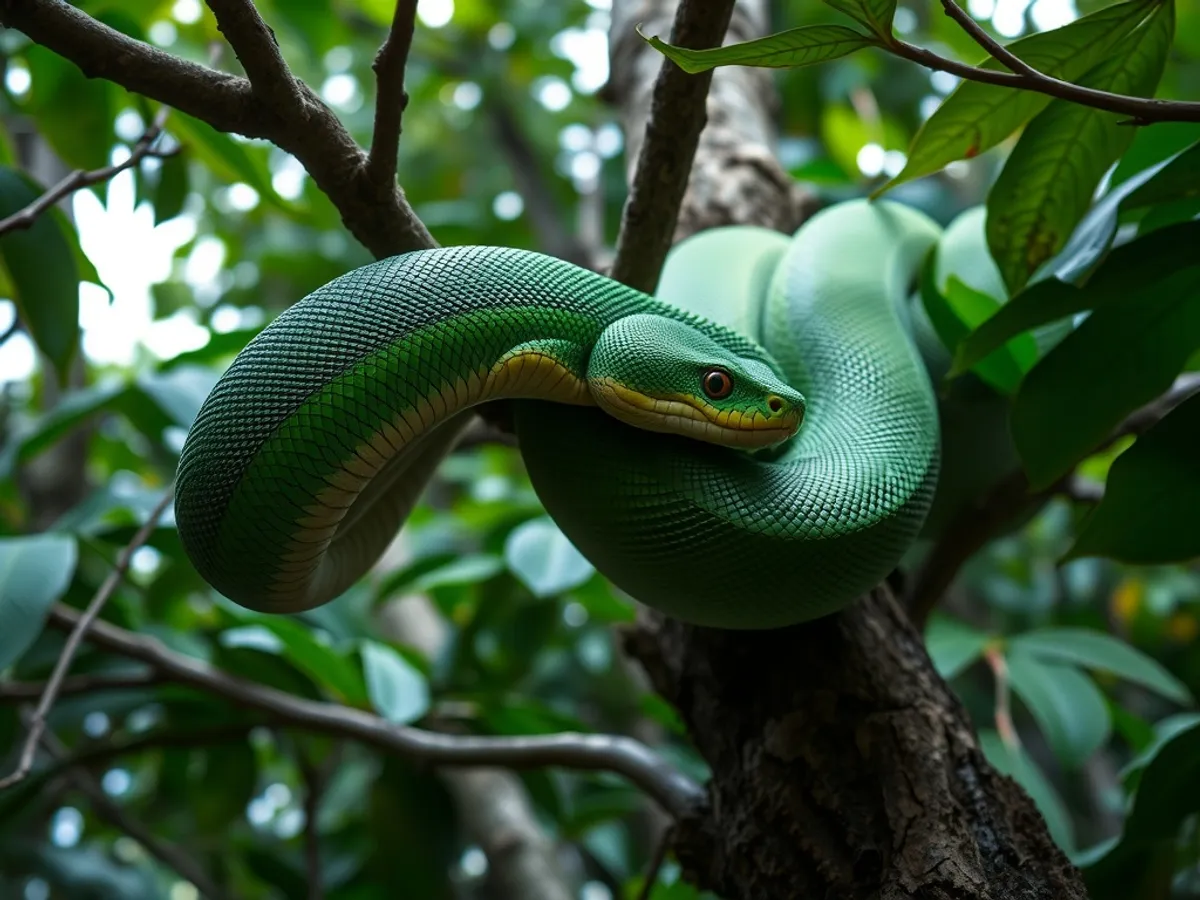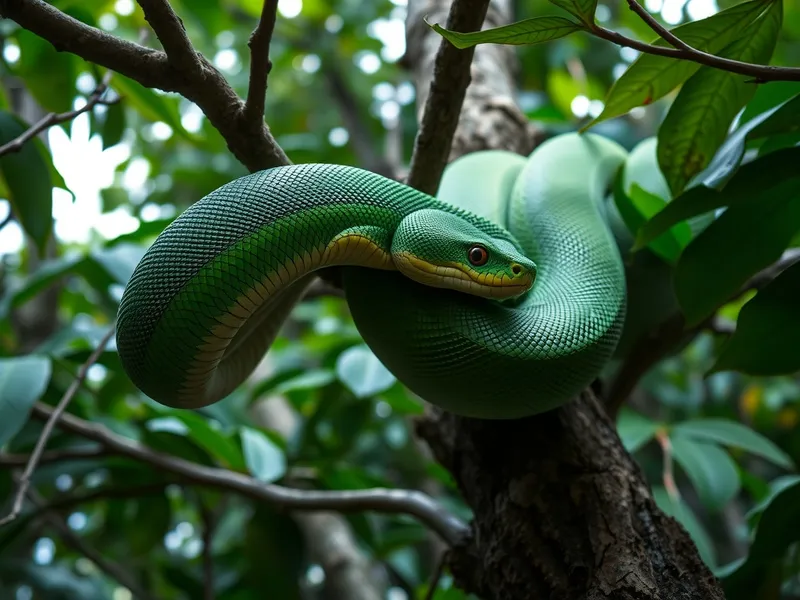
Emerald Tree Boa
Corallus caninus

Meet the Emerald Tree Boa
The Emerald Tree Boa is a strikingly beautiful non-venomous snake known for its vivid green coloration and white zigzag markings. Native to the rainforests of South America, it spends most of its life coiled on tree branches, perfectly camouflaged among the leaves. This species is an ambush predator, using its strong prehensile tail to anchor itself while it waits patiently for prey. Despite its intimidating appearance, the Emerald Tree Boa is harmless to humans and is admired by herpetologists for its unique adaptations to arboreal life.
Classification
Reptile
Habitat
Tropical rainforest canopy
Diet
Carnivore
Lifespan
15-20 years
Conservation
Least Concern
Weight
1-2 kg
📖Fascinating Facts
Arboreal Lifestyle
Emerald Tree Boas spend nearly their entire lives in the trees, rarely descending to the ground except to move between trees or find water.
Ambush Predator
This snake hunts by remaining motionless for hours, waiting for small mammals or birds to come within striking distance before seizing them with lightning-fast reflexes.
Color Changing
Juvenile Emerald Tree Boas are born bright orange or red, gradually turning emerald green as they mature over 12-18 months.
📋Detailed Description
The Emerald Tree Boa (Corallus caninus) is a medium to large arboreal snake, typically reaching lengths of 1.5 to 2 meters (5–6.5 feet), with some individuals exceeding 2.2 meters. It is renowned for its vivid emerald-green dorsal coloration, accented by irregular white or yellow zigzag or diamond-shaped markings along its back, which provide effective camouflage among the rainforest canopy. The ventral surface is usually yellowish, and juveniles are born brick-red to orange, gradually acquiring their adult coloration after 9–12 months. The head is broad and noticeably angular, with prominent heat-sensing pits along the upper and lower labial scales, aiding in the detection of warm-blooded prey. The body is muscular and laterally compressed, with a prehensile tail that facilitates climbing and anchoring among branches. Emerald Tree Boas are primarily nocturnal and spend daylight hours coiled in a characteristic saddle position on branches. They are solitary and highly territorial, rarely interacting outside of breeding. Their diet consists mainly of small mammals, birds, and occasionally lizards, which they ambush using a rapid strike and constriction. Reproduction is ovoviviparous; females give birth to live young after a lengthy gestation. Adapted to humid, lowland rainforests, they are found throughout the Amazon Basin, including Brazil, Colombia, Venezuela, Ecuador, Peru, and Bolivia. Their cryptic coloration and arboreal lifestyle make them elusive and well-protected from many predators.
💡 Did you know?
The Emerald Tree Boa has almost identical coloration and habits to the Green Tree Python of Australia, despite not being closely related—a classic example of convergent evolution.
🔬Research & Sources
Wikipedia Summary
The emerald tree boa is a boa species found in the rainforests of South America. Since 2009 the species Corallus batesii has been distinguished from the emerald tree boa. Like all other boas, it is nonvenomous. Trade of the species is controlled internationally under CITES Appendix II.
Last Modified: 12/24/2024
🎭Behavior & Social Structure
Emerald Tree Boas are ambush predators, relying on stealth and patience rather than active pursuit. By day, they rest coiled on branches, often in a saddle-shaped loop with the head resting in the center, minimizing movement and exposure. At night, they become active, using their heat-sensing pits to locate prey in the dark. When prey approaches, the boa strikes quickly, securing it with its sharp, recurved teeth and then constricting until suffocation. Feeding occurs infrequently, as their slow metabolism allows them to go weeks or even months between meals. Social interactions are minimal; individuals are solitary and may display defensive behaviors such as hissing or striking if threatened. They are not aggressive unless provoked and generally avoid confrontation. During the breeding season, males may exhibit increased activity and occasionally engage in combat for access to receptive females.
👶Reproduction & Life Cycle
Emerald Tree Boas are ovoviviparous, meaning females retain eggs internally until the young are ready to hatch. Breeding typically occurs during the rainy season, with courtship involving tongue-flicking and body alignment. Males may engage in combat by intertwining and pushing each other. After successful mating, gestation lasts approximately 6–7 months (180–210 days). Females give birth to litters of 6–20 live young, each measuring about 30–50 cm (12–20 inches) at birth. Neonates are brightly colored (red, orange, or yellow) and become independent immediately, receiving no parental care. The color transition to green occurs over the first year of life. Sexual maturity is reached at 3–4 years for females and slightly earlier for males.
🛡️Adaptations & Survival
The Emerald Tree Boa exhibits several specialized adaptations for arboreal life. Its prehensile tail provides a strong grip on branches, allowing it to anchor securely while striking at prey or resting. The laterally compressed body aids in maneuvering through dense foliage. Its large, recurved teeth are among the longest (relative to body size) of any non-venomous snake, facilitating the capture of agile, feathered prey such as birds. Heat-sensing pits enable detection of endothermic animals in low-light conditions. The cryptic green coloration with disruptive white markings provides effective camouflage against predators and prey alike. Slow metabolism and infrequent feeding are advantageous in an environment where prey may be sporadic. The species' ability to change color as juveniles may reduce predation by mimicking other toxic or unpalatable species.
📚Research Sources
🎨Cultural Significance
The Emerald Tree Boa holds a place in indigenous Amazonian folklore, often symbolizing stealth, beauty, or the mysterious aspects of the rainforest. Its striking appearance has made it a popular subject in art and ecotourism, and it is frequently displayed in zoos and reptile collections worldwide. While not traditionally used for food or medicine, its image is sometimes incorporated into local crafts and storytelling. In Western culture, it is admired for its vivid coloration and unique adaptations, contributing to public interest in rainforest conservation.
🔬Recent Research & Discoveries
Recent molecular studies have clarified the taxonomy of Corallus caninus, distinguishing it from the closely related Corallus batesii (Amazon Basin Emerald Tree Boa) based on genetic and morphological differences. Ongoing research focuses on the species' thermal ecology, reproductive physiology, and the ontogeny of color change in juveniles. Studies using radio telemetry have provided insights into home range size, movement patterns, and habitat preferences. Conservation genetics research is assessing the impact of habitat fragmentation on population structure. Captive breeding programs have improved understanding of reproductive cycles and neonate development, aiding both conservation and the responsible pet trade.
🎥Wildlife Videos

Emerald tree Boa facts
I hope you enjoy this video Don't forget to like, comment and subscribe Good luck to all of you #Snake #animals.
Animal University

EMERALD TREE BOAS IN THE WILD! (Are we keeping them correctly?)
Tree boas, especially Emerald tree boas are the most sought after snakes in the amazon rainforest, but also in herpetoculture.
Dāv Kaufman's Reptile Adventures

The Secret Hunting Life of the Emerald Tree Boa
Discover the fascinating world of the Emerald Tree Boa, one of nature's most striking and efficient predators. This captivating video ...
Did You Know

Emerald tree boa, a beautiful snake from the Amazon rainforest
The Northern emerald tree boa (Corallus caninus) is a stunningly beautiful species! In the past it was the same species with the ...
Living Zoology

Why the Emerald Tree Boa Is the Most Beautiful Predator in the Jungle
Why the Emerald Tree Boa Is the Most Beautiful Predator in the Jungle #EmeraldTreeBoa #JunglePredator #AmazonSnake ...
Nhung Zoology

Emerald Tree Boa: Nature's Perfect Predator #shortsvideo #wildlife #venomoussnake
Discover the fascinating world of the Emerald Tree Boa, one of nature's most striking and efficient predators. This captivating video ...
Did You Know
🌍Habitat Information
The Emerald Tree Boa typically inhabits Tropical rainforest canopy environments. Emerald Tree Boas have adapted to their environments with specialized features and behaviors.
Primary Habitat:
Tropical rainforest canopy
More detailed habitat information will be available soon.
🛡️Conservation Status
The Emerald Tree Boa is currently classified as Least Concern. Conservation efforts are crucial for preserving this species for future generations.
Common Threats:
- 🏠Habitat loss and fragmentation
- 🌡️Climate change impacts
- 🎯Hunting and poaching
- 🏭Human-wildlife conflict
⚠️Threats & Conservation Challenges
Currently classified as Least Concern by the IUCN, the Emerald Tree Boa faces localized threats from habitat destruction due to deforestation, agricultural expansion, and logging in the Amazon Basin. Illegal collection for the pet trade, despite CITES Appendix II protection, remains a concern, particularly for wild-caught individuals. Climate change poses a long-term threat by altering rainforest ecosystems and microclimates. While populations are stable in remote regions, fragmentation of habitat can lead to genetic isolation and reduced resilience. Road construction and human encroachment increase the risk of mortality and further habitat loss.
🔬Scientific Classification
Scientific Name
Corallus caninus
Classification Hierarchy
🔍 About Taxonomic Classification
Taxonomic classification is a hierarchical system used by scientists to classify and organize living organisms based on shared characteristics and evolutionary relationships.
The system moves from broad categories (Kingdom) to increasingly specific ones, with each animal's scientific name typically consisting of its Genus and species.
📝Community Notes
Share your observations and insights about the Emerald Tree Boa with our community of wildlife enthusiasts.
Join Our Community
Sign in to share your observations and connect with fellow wildlife enthusiasts.
Sign In to ContributeNo community notes yet
Be the first to share your observations about the Emerald Tree Boa!
Explore Emerald Tree Boa
Select a tab above to learn more about this amazing animal.
📸Photo Gallery
No photos available for this animal yet.
🌟Discover More Wildlife
Continue your journey of discovery with more fascinating animals from our database
